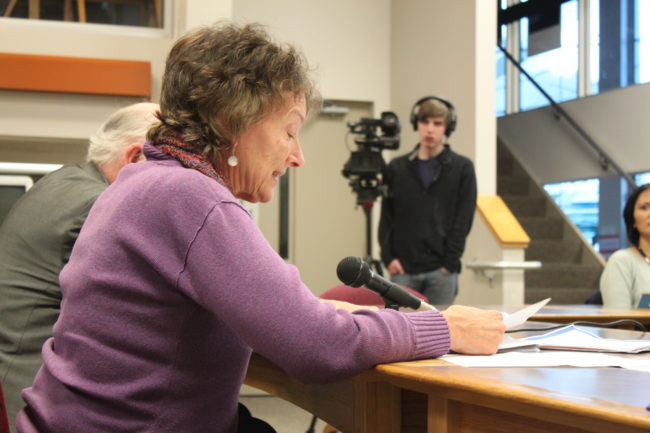
The Juneau school board voted unanimously to approve a budget that would increase the number of students in a classroom, cut teaching positions, and implement a new elementary language arts curriculum.
During Tuesday night’s special school board meeting at Juneau-Douglas High School, public testimony and board discussion focused once again on the debate over small classes versus new curriculum, a $500,000 line item in the administration’s budget for the 2014-2015 school year.
School board student representative Ruby Steedle said the administration’s budget places more value on curriculum than teachers.
“When I think about all the schools I’ve gone through in the Juneau School District, I don’t think about the textbook we’ve had, I think about the teachers I’ve had. And I understand that a curriculum will help our students. There’s no way to argue that having a curriculum that’s uniform across all the schools in our district won’t make a difference. But I don’t think we should make that choice at the cost of teachers,” Steedle said.
Stacy Diouf is a special education support teacher who works throughout the district. She supports a new language arts curriculum and said it will reduce the differences in teaching strategy.
“As a result of these differences, for many of our students, their education and academic achievement is inconsistent, which leads to gaps in reading skills, which in turn leads to significant reading problems over time. Many of these students end up in special education because they are so far behind their peers,” Diouf said.
School board member Phyllis Carlson said the effectiveness of smaller class size is debatable. While the board’s priority is to serve every student, the school district is leaving many behind. A new curriculum, Carlson said, will fix that.
“We’ve heard from many teachers. A lot of teachers who want to wait or aren’t supportive of a curriculum may not have the same high-needs students in their buildings. I’m not sure … Obviously common sense will tell you, if you have a smaller class size, if I have a class of 15, I’m obviously going to have a better relationship and opportunities, but that costs a lot of money and we don’t have that right now,” Carlson said.
The school district faces a budget shortfall of close to four and half million dollars, partly due to a decline in the number of students and an increase in employee salary and benefits.
School board vice president Sean O’Brien said a new curriculum will help manage bigger classes. He said smaller class sizes did not help a third of the students who are reading below grade level or the 21 percent not graduating
“If what we were doing in the past was effective and it worked, we would not be having the issues that we’re having today – period,” he said.
Several bills before the Alaska State Legislature would raise the base student allocation, which is the amount districts get from the state for each enrolled student.
If pending legislation brings the school district more funding, the administration’s first priority is to still increase the class size, but by fewer students.
(Editor’s note: A reference to a per pupil funding term has been corrected. The term is “base student allocation,” not “Base School Allocation.”)
